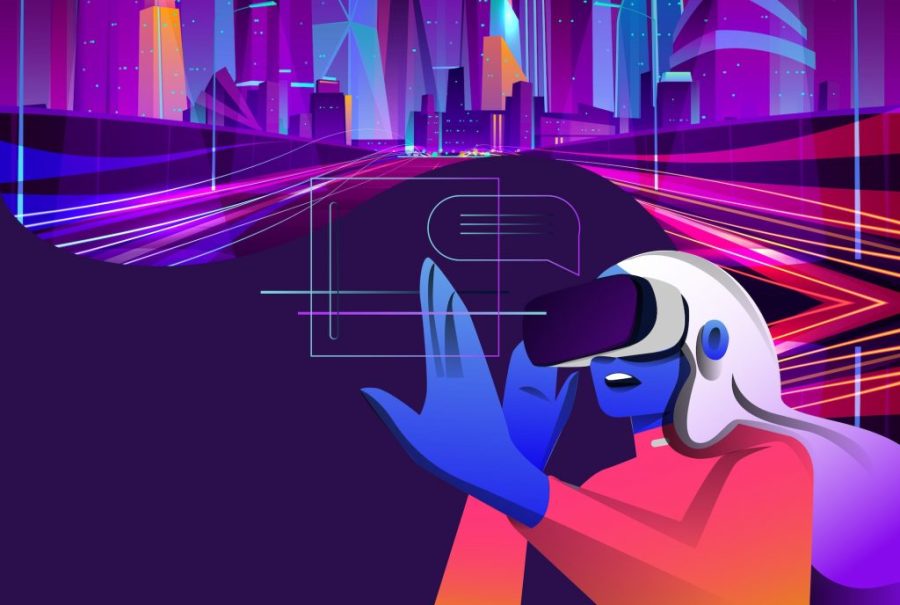The term “metaverse” has been all over the news since Facebook changed its name to Meta in October. Chinese companies are not far behind, either: ByteDance purchased virtual reality (VR) headset maker Pico earlier this year, while Tencent recently outlined three “pathways” – video games, a social network, and augmented reality (AR) and VR – to fulfill its metaverse ambitions.
With this virtual world making headlines all over, we can’t help but wonder: Why did the metaverse suddenly become a new battleground for tech behemoths? And how could it impact our day-to-day lives? Let’s start with the basics.
What is the metaverse?
A combination of “meta” (implying “beyond”) and “universe”, the metaverse can be described as a natural, 3D virtual environment that blends the physical and digital realms by harnessing the internet and extended reality such as VR and AR.
When sharing his vision via a Founder’s Letter on 28 October, Facebook CEO Mark Zuckerberg defined the metaverse as “an embodied internet where you’re in the experience, not just looking at it” that “will be the successor to the mobile internet”.
At the moment, our online interactions centre on websites and messaging applications. However, with the metaverse, new online spaces will enable more immersive and multi-dimensional interactions using personal avatars (digital representations of users).
Covid-19 has also fueled momentum behind the metaverse, as more people embrace virtual experiences and seek out increasingly life-like interactions. Video communication tools such as Zoom, audio social platform Clubhouse, and immersive online games like Animal Crossing or Among Us have all started to blur the lines between physical and virtual.
Where did the concept come from?
The idea of a metaverse has been around for some time: American writer Neal Stephenson coined the term in Snow Crash. In this 1992 science fiction novel, Stephenson defines the metaverse as a massive virtual environment parallel to the physical world.
The protagonist of Snow Crash, named Hiro, is a pizza delivery man and hacker who’s “in a computer-generated universe that his computer is drawing into his goggles and pumping into his earphones.” He spends a lot of time in “this imaginary place” called the “Metaverse”, Stephenson wrote in the book.
“He is not seeing real people, of course. This is all a part of the moving illustration drawn by his computer, according to specifications coming down the fibre-optic cable. The people are pieces of software called avatars.”

How does the metaverse work?
Generated by computers, a metaverse enables us to live virtual lives the same way we’d live physical lives. To make this possible, the metaverse requires personalised avatars, content generators and a virtual economy – all of which can be made possible via VR, AR, computer vision, 3D modelling, 5G, cloud computing, digital currencies, blockchain and NFTs (non-fungible tokens).
While the metaverse may seem like a long way off, we already have the technology needed to develop a shared online world that mirrors reality. Most likely, different companies will create virtual spaces such as shops, theme parks and performances that users can experience online. However, to have a true metaverse, we also need seamless transitions from one virtual space to the next so users can shuttle around smoothly.
How could the metaverse change the way we live, work and communicate?
Building off recent shifts to remote work spurred by the pandemic, Facebook is testing a professional version of the metaverse called Horizon Workrooms. The programme invites users of Oculus, a VR headset and gaming company Facebook purchased in 2014, to enter virtual offices and hold meetings. Likewise, Microsoft launched a similar experience, Mesh, earlier this year.
But of course, there’s more to life than work, so companies are also creating online spaces to connect users through virtual entertainment and travel. In August, Fortnite’s Ariana Grande virtual concerts offered a taste of “live” music in the metaverse. Gaming platform Roblox also launched an interactive virtual skatepark where users can practice their virtual kickflips and ollies.
In the fashion world, Roblox teamed up with Gucci in May to introduce a virtual Gucci Garden shopping experience, where players could buy limited-edition clothes and bags for their avatars, as well as mingle with other users. One virtual Gucci bag sold for over US$4,000 – more than it cost in real life.
Disney also developed a new app, Play Disney Parks, enabling users to play VR and AR games at Disney theme parks in Florida and California. While not precisely the metaverse, these developments are headed toward an increasingly immersive, functional and shared online world.
For Macao, the metaverse could also open new doors for tourism. For instance, the city could offer everything from immersive shopping experiences to performances, walking tours, rides, artistic experiences, conferences and more.

Why is there so much hype around the metaverse?
From a business perspective, tech companies and investors see a new world of potential. According to Bloomberg Intelligence, the market size of the metaverse will likely reach US$800 billion by 2024.
Just think about replicating our physical world online – opportunities abound for nearly every industry, from virtual banking to cars to window blinds, and many companies want to get in on the ground floor. Though they haven’t revealed concrete plans, businesses like electric vehicle maker XPeng Motors and networking app Soul have expressed ambitions to be the first from their respective industries in China to embrace the metaverse.
According to The Paper, a Chinese news website, nearly 400 Chinese companies have registered metaverse-related trademarks as of this October. Just this month, the China Mobile Communications Federation, which counts China Mobile and China Unicom as members, announced the creation of its first-ever Metaverse Industry Committee.
What are the downsides?
Cloud computing is crucial to the metaverse, yet data storage and processing can carry huge environmental costs. Considering the scale, variety and speed of data a metaverse would require, it will likely be the unprecedented energy consumer and carbon emitter in human history.
Plus, Zuckerberg’s vision to move from a social media company towards a metaverse company may heighten, instead of mitigating, the unsolved challenges Facebook and other tech giants currently face, such as personal privacy, misinformation and antitrust — just think about the amount and variety of data a company will be able to gather once its own metaverse is built.

When can we enter the metaverse?
While there’s plenty of momentum behind the metaverse, we’re not going to see hyper-realistic virtual worlds for another five years, at least. Even Zuckerberg confessed that his investments in the metaverse wouldn’t be profitable for at least a few years. If development progresses smoothly and society embraces the experiences, 3D virtual worlds may become a mainstream way to work, shop, dine and interact within the next decade.






